EHR System Case Study: Implementation, Challenges & Recommendations
VerifiedAdded on 2023/06/13
|17
|3253
|332
Case Study
AI Summary
This case study proposes an implementation of an Electronic Health Record (EHR) system using enterprise resource modeling to improve healthcare management. It details the architecture required for the EHR system, including conceptual and logical forms, and illustrates the relationships and communication flow between system components. The study also identifies challenges such as implementation barriers, learning curves, and data integration issues, and suggests strategies for overcoming them. Furthermore, it discusses opportunities for enhancing patient safety, service efficiency, and data management within the healthcare sector, providing recommendations for system improvement and future development. This document is shared on Desklib, a platform offering AI-powered study tools and a wide range of student resources, including past papers and solved assignments.

Case Study-EHR System
Name of the Student
Name of the University
Authors note
Name of the Student
Name of the University
Authors note
Paraphrase This Document
Need a fresh take? Get an instant paraphrase of this document with our AI Paraphraser
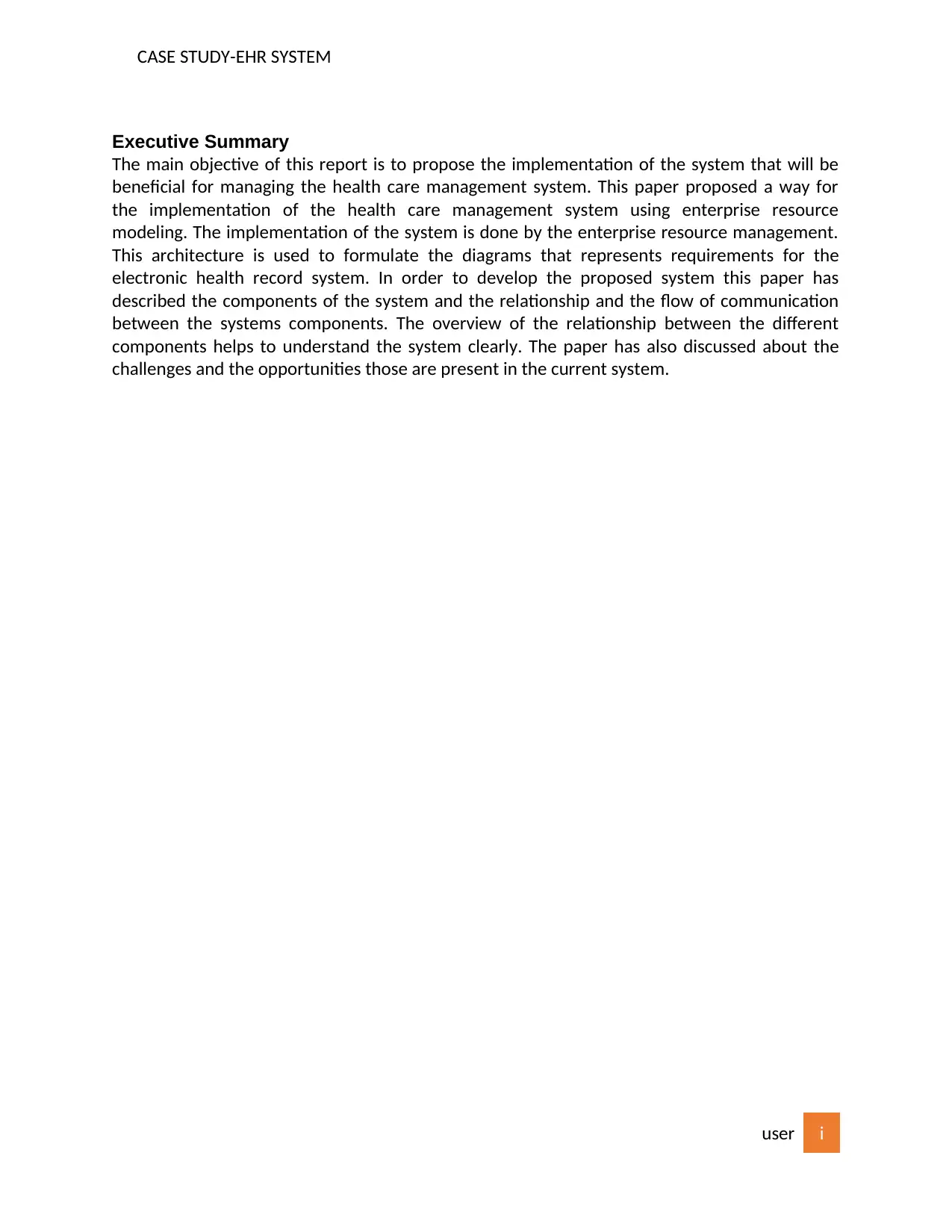
CASE STUDY-EHR SYSTEM
Executive Summary
The main objective of this report is to propose the implementation of the system that will be
beneficial for managing the health care management system. This paper proposed a way for
the implementation of the health care management system using enterprise resource
modeling. The implementation of the system is done by the enterprise resource management.
This architecture is used to formulate the diagrams that represents requirements for the
electronic health record system. In order to develop the proposed system this paper has
described the components of the system and the relationship and the flow of communication
between the systems components. The overview of the relationship between the different
components helps to understand the system clearly. The paper has also discussed about the
challenges and the opportunities those are present in the current system.
user i
Executive Summary
The main objective of this report is to propose the implementation of the system that will be
beneficial for managing the health care management system. This paper proposed a way for
the implementation of the health care management system using enterprise resource
modeling. The implementation of the system is done by the enterprise resource management.
This architecture is used to formulate the diagrams that represents requirements for the
electronic health record system. In order to develop the proposed system this paper has
described the components of the system and the relationship and the flow of communication
between the systems components. The overview of the relationship between the different
components helps to understand the system clearly. The paper has also discussed about the
challenges and the opportunities those are present in the current system.
user i
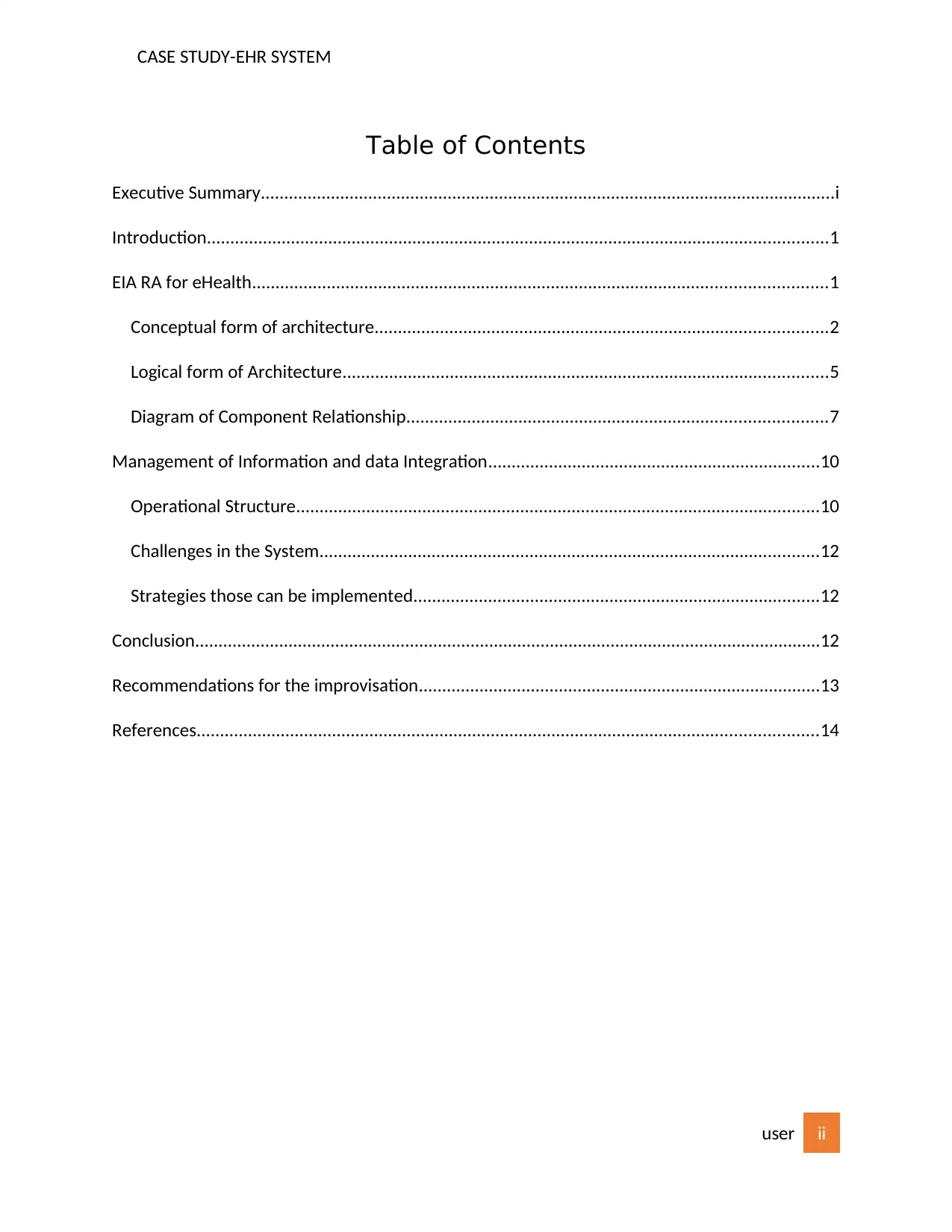
CASE STUDY-EHR SYSTEM
Table of Contents
Executive Summary...........................................................................................................................i
Introduction.....................................................................................................................................1
EIA RA for eHealth...........................................................................................................................1
Conceptual form of architecture.................................................................................................2
Logical form of Architecture........................................................................................................5
Diagram of Component Relationship..........................................................................................7
Management of Information and data Integration.......................................................................10
Operational Structure................................................................................................................10
Challenges in the System...........................................................................................................12
Strategies those can be implemented.......................................................................................12
Conclusion......................................................................................................................................12
Recommendations for the improvisation......................................................................................13
References.....................................................................................................................................14
user ii
Table of Contents
Executive Summary...........................................................................................................................i
Introduction.....................................................................................................................................1
EIA RA for eHealth...........................................................................................................................1
Conceptual form of architecture.................................................................................................2
Logical form of Architecture........................................................................................................5
Diagram of Component Relationship..........................................................................................7
Management of Information and data Integration.......................................................................10
Operational Structure................................................................................................................10
Challenges in the System...........................................................................................................12
Strategies those can be implemented.......................................................................................12
Conclusion......................................................................................................................................12
Recommendations for the improvisation......................................................................................13
References.....................................................................................................................................14
user ii
⊘ This is a preview!⊘
Do you want full access?
Subscribe today to unlock all pages.

Trusted by 1+ million students worldwide
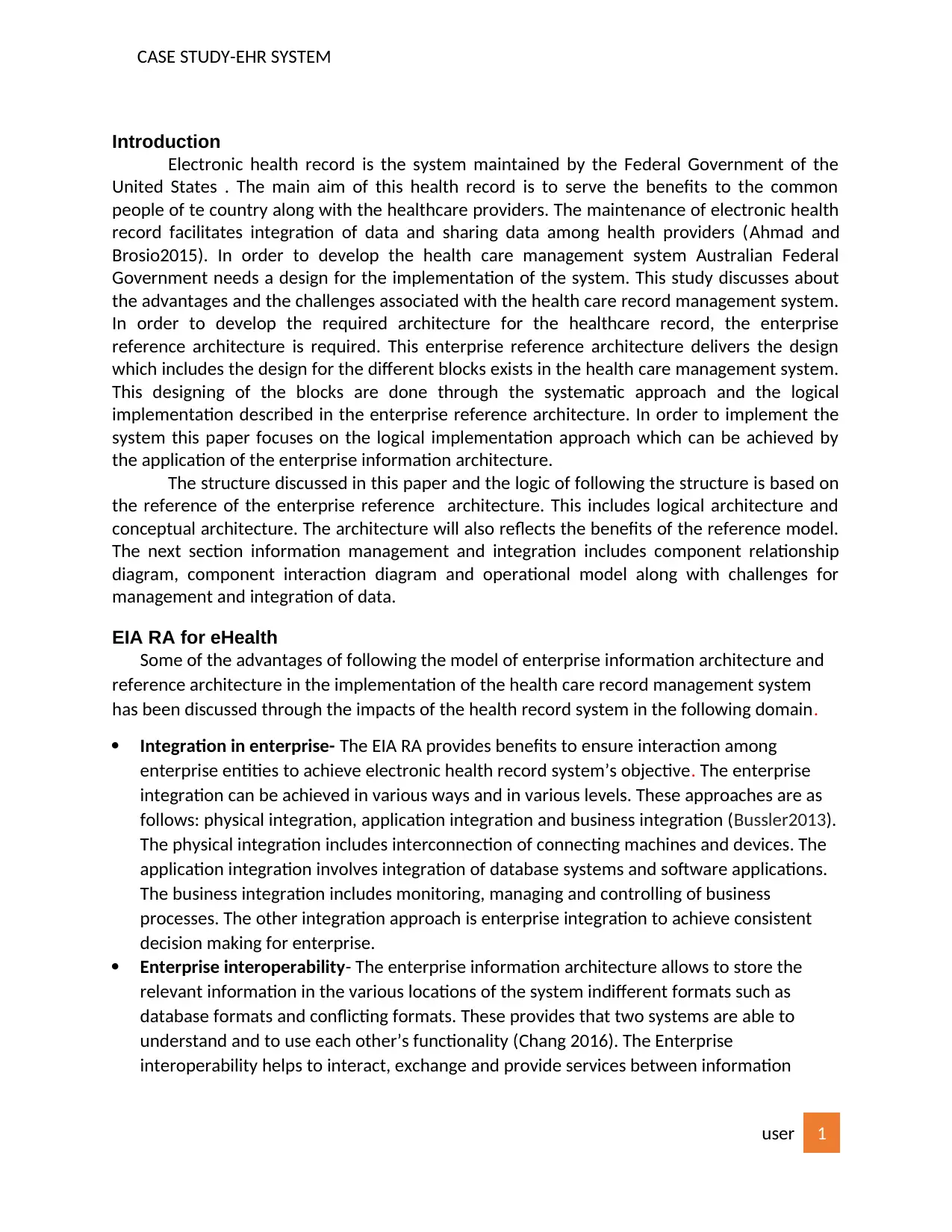
CASE STUDY-EHR SYSTEM
Introduction
Electronic health record is the system maintained by the Federal Government of the
United States . The main aim of this health record is to serve the benefits to the common
people of te country along with the healthcare providers. The maintenance of electronic health
record facilitates integration of data and sharing data among health providers (Ahmad and
Brosio2015). In order to develop the health care management system Australian Federal
Government needs a design for the implementation of the system. This study discusses about
the advantages and the challenges associated with the health care record management system.
In order to develop the required architecture for the healthcare record, the enterprise
reference architecture is required. This enterprise reference architecture delivers the design
which includes the design for the different blocks exists in the health care management system.
This designing of the blocks are done through the systematic approach and the logical
implementation described in the enterprise reference architecture. In order to implement the
system this paper focuses on the logical implementation approach which can be achieved by
the application of the enterprise information architecture.
The structure discussed in this paper and the logic of following the structure is based on
the reference of the enterprise reference architecture. This includes logical architecture and
conceptual architecture. The architecture will also reflects the benefits of the reference model.
The next section information management and integration includes component relationship
diagram, component interaction diagram and operational model along with challenges for
management and integration of data.
EIA RA for eHealth
Some of the advantages of following the model of enterprise information architecture and
reference architecture in the implementation of the health care record management system
has been discussed through the impacts of the health record system in the following domain.
Integration in enterprise- The EIA RA provides benefits to ensure interaction among
enterprise entities to achieve electronic health record system’s objective. The enterprise
integration can be achieved in various ways and in various levels. These approaches are as
follows: physical integration, application integration and business integration (Bussler2013).
The physical integration includes interconnection of connecting machines and devices. The
application integration involves integration of database systems and software applications.
The business integration includes monitoring, managing and controlling of business
processes. The other integration approach is enterprise integration to achieve consistent
decision making for enterprise.
Enterprise interoperability- The enterprise information architecture allows to store the
relevant information in the various locations of the system indifferent formats such as
database formats and conflicting formats. These provides that two systems are able to
understand and to use each other’s functionality (Chang 2016). The Enterprise
interoperability helps to interact, exchange and provide services between information
user 1
Introduction
Electronic health record is the system maintained by the Federal Government of the
United States . The main aim of this health record is to serve the benefits to the common
people of te country along with the healthcare providers. The maintenance of electronic health
record facilitates integration of data and sharing data among health providers (Ahmad and
Brosio2015). In order to develop the health care management system Australian Federal
Government needs a design for the implementation of the system. This study discusses about
the advantages and the challenges associated with the health care record management system.
In order to develop the required architecture for the healthcare record, the enterprise
reference architecture is required. This enterprise reference architecture delivers the design
which includes the design for the different blocks exists in the health care management system.
This designing of the blocks are done through the systematic approach and the logical
implementation described in the enterprise reference architecture. In order to implement the
system this paper focuses on the logical implementation approach which can be achieved by
the application of the enterprise information architecture.
The structure discussed in this paper and the logic of following the structure is based on
the reference of the enterprise reference architecture. This includes logical architecture and
conceptual architecture. The architecture will also reflects the benefits of the reference model.
The next section information management and integration includes component relationship
diagram, component interaction diagram and operational model along with challenges for
management and integration of data.
EIA RA for eHealth
Some of the advantages of following the model of enterprise information architecture and
reference architecture in the implementation of the health care record management system
has been discussed through the impacts of the health record system in the following domain.
Integration in enterprise- The EIA RA provides benefits to ensure interaction among
enterprise entities to achieve electronic health record system’s objective. The enterprise
integration can be achieved in various ways and in various levels. These approaches are as
follows: physical integration, application integration and business integration (Bussler2013).
The physical integration includes interconnection of connecting machines and devices. The
application integration involves integration of database systems and software applications.
The business integration includes monitoring, managing and controlling of business
processes. The other integration approach is enterprise integration to achieve consistent
decision making for enterprise.
Enterprise interoperability- The enterprise information architecture allows to store the
relevant information in the various locations of the system indifferent formats such as
database formats and conflicting formats. These provides that two systems are able to
understand and to use each other’s functionality (Chang 2016). The Enterprise
interoperability helps to interact, exchange and provide services between information
user 1
Paraphrase This Document
Need a fresh take? Get an instant paraphrase of this document with our AI Paraphraser
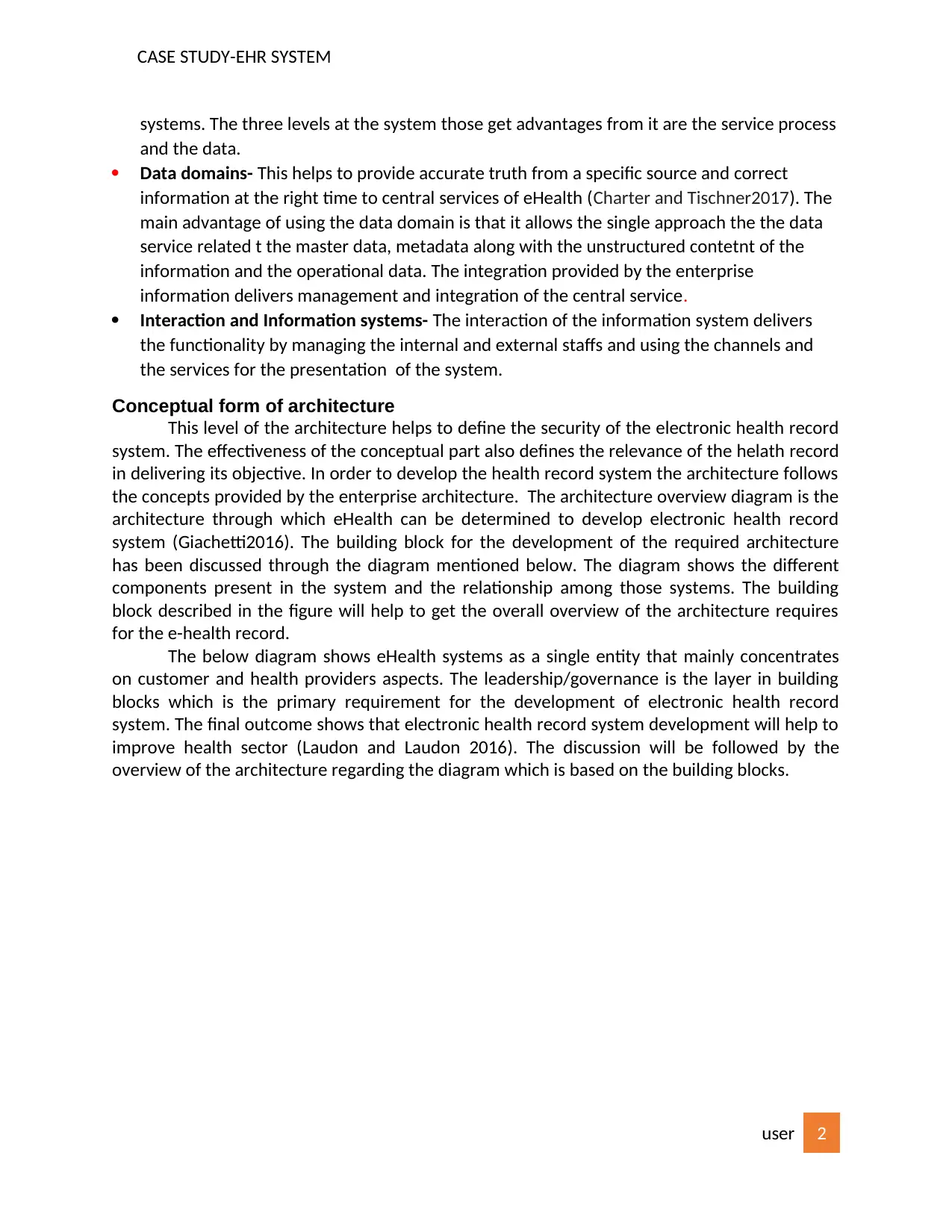
CASE STUDY-EHR SYSTEM
systems. The three levels at the system those get advantages from it are the service process
and the data.
Data domains- This helps to provide accurate truth from a specific source and correct
information at the right time to central services of eHealth (Charter and Tischner2017). The
main advantage of using the data domain is that it allows the single approach the the data
service related t the master data, metadata along with the unstructured contetnt of the
information and the operational data. The integration provided by the enterprise
information delivers management and integration of the central service.
Interaction and Information systems- The interaction of the information system delivers
the functionality by managing the internal and external staffs and using the channels and
the services for the presentation of the system.
Conceptual form of architecture
This level of the architecture helps to define the security of the electronic health record
system. The effectiveness of the conceptual part also defines the relevance of the helath record
in delivering its objective. In order to develop the health record system the architecture follows
the concepts provided by the enterprise architecture. The architecture overview diagram is the
architecture through which eHealth can be determined to develop electronic health record
system (Giachetti2016). The building block for the development of the required architecture
has been discussed through the diagram mentioned below. The diagram shows the different
components present in the system and the relationship among those systems. The building
block described in the figure will help to get the overall overview of the architecture requires
for the e-health record.
The below diagram shows eHealth systems as a single entity that mainly concentrates
on customer and health providers aspects. The leadership/governance is the layer in building
blocks which is the primary requirement for the development of electronic health record
system. The final outcome shows that electronic health record system development will help to
improve health sector (Laudon and Laudon 2016). The discussion will be followed by the
overview of the architecture regarding the diagram which is based on the building blocks.
user 2
systems. The three levels at the system those get advantages from it are the service process
and the data.
Data domains- This helps to provide accurate truth from a specific source and correct
information at the right time to central services of eHealth (Charter and Tischner2017). The
main advantage of using the data domain is that it allows the single approach the the data
service related t the master data, metadata along with the unstructured contetnt of the
information and the operational data. The integration provided by the enterprise
information delivers management and integration of the central service.
Interaction and Information systems- The interaction of the information system delivers
the functionality by managing the internal and external staffs and using the channels and
the services for the presentation of the system.
Conceptual form of architecture
This level of the architecture helps to define the security of the electronic health record
system. The effectiveness of the conceptual part also defines the relevance of the helath record
in delivering its objective. In order to develop the health record system the architecture follows
the concepts provided by the enterprise architecture. The architecture overview diagram is the
architecture through which eHealth can be determined to develop electronic health record
system (Giachetti2016). The building block for the development of the required architecture
has been discussed through the diagram mentioned below. The diagram shows the different
components present in the system and the relationship among those systems. The building
block described in the figure will help to get the overall overview of the architecture requires
for the e-health record.
The below diagram shows eHealth systems as a single entity that mainly concentrates
on customer and health providers aspects. The leadership/governance is the layer in building
blocks which is the primary requirement for the development of electronic health record
system. The final outcome shows that electronic health record system development will help to
improve health sector (Laudon and Laudon 2016). The discussion will be followed by the
overview of the architecture regarding the diagram which is based on the building blocks.
user 2
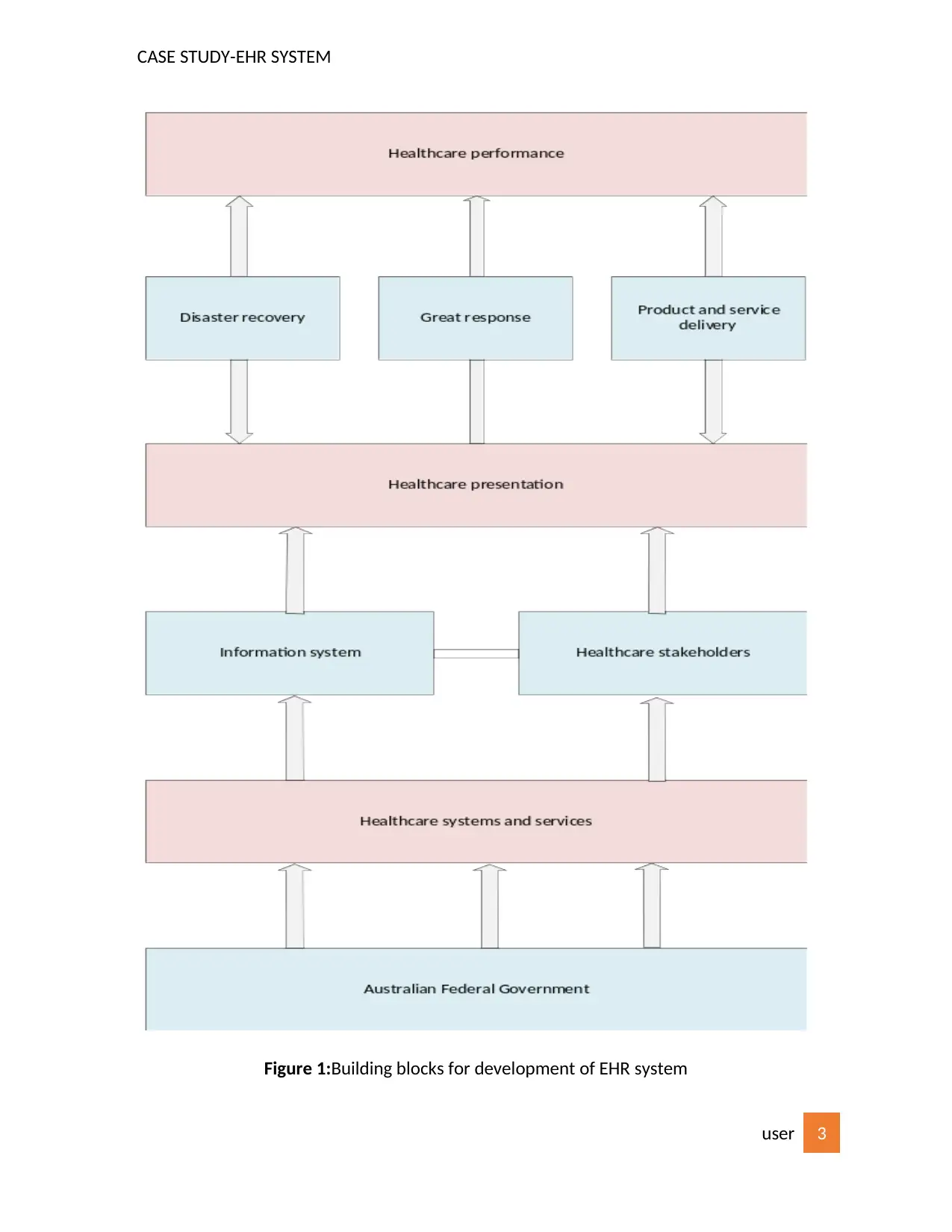
CASE STUDY-EHR SYSTEM
Figure 1:Building blocks for development of EHR system
user 3
Figure 1:Building blocks for development of EHR system
user 3
⊘ This is a preview!⊘
Do you want full access?
Subscribe today to unlock all pages.

Trusted by 1+ million students worldwide
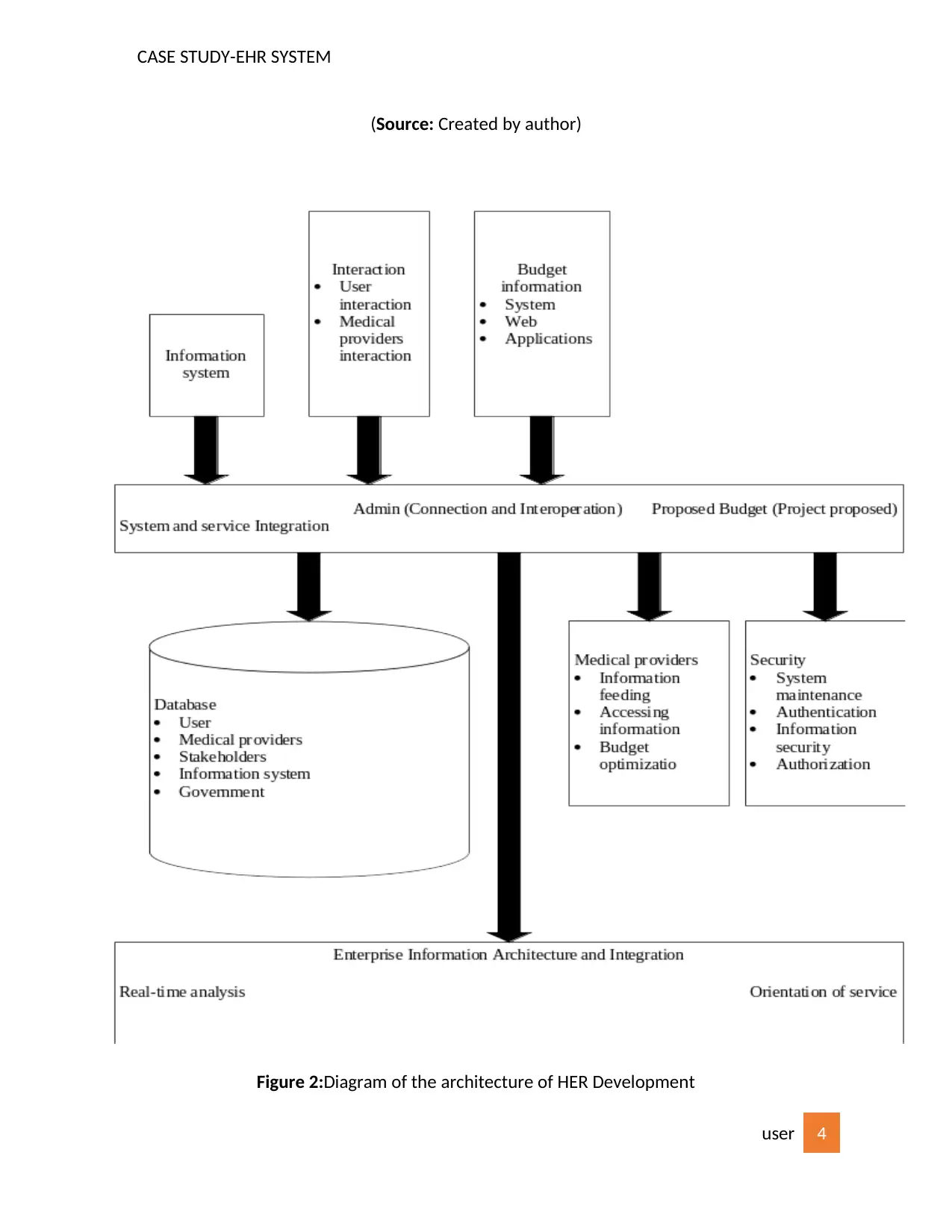
CASE STUDY-EHR SYSTEM
(Source: Created by author)
Figure 2:Diagram of the architecture of HER Development
user 4
(Source: Created by author)
Figure 2:Diagram of the architecture of HER Development
user 4
Paraphrase This Document
Need a fresh take? Get an instant paraphrase of this document with our AI Paraphraser
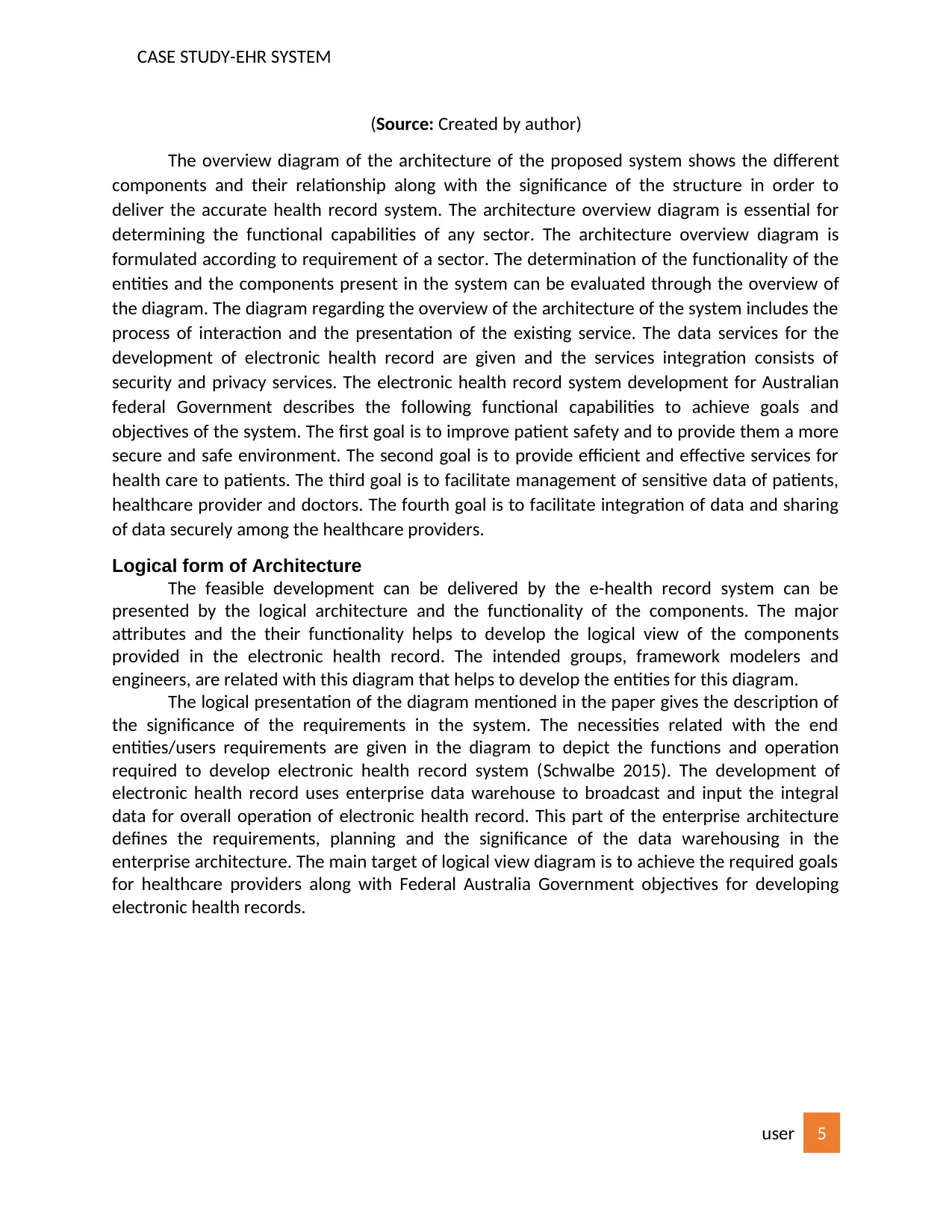
CASE STUDY-EHR SYSTEM
(Source: Created by author)
The overview diagram of the architecture of the proposed system shows the different
components and their relationship along with the significance of the structure in order to
deliver the accurate health record system. The architecture overview diagram is essential for
determining the functional capabilities of any sector. The architecture overview diagram is
formulated according to requirement of a sector. The determination of the functionality of the
entities and the components present in the system can be evaluated through the overview of
the diagram. The diagram regarding the overview of the architecture of the system includes the
process of interaction and the presentation of the existing service. The data services for the
development of electronic health record are given and the services integration consists of
security and privacy services. The electronic health record system development for Australian
federal Government describes the following functional capabilities to achieve goals and
objectives of the system. The first goal is to improve patient safety and to provide them a more
secure and safe environment. The second goal is to provide efficient and effective services for
health care to patients. The third goal is to facilitate management of sensitive data of patients,
healthcare provider and doctors. The fourth goal is to facilitate integration of data and sharing
of data securely among the healthcare providers.
Logical form of Architecture
The feasible development can be delivered by the e-health record system can be
presented by the logical architecture and the functionality of the components. The major
attributes and the their functionality helps to develop the logical view of the components
provided in the electronic health record. The intended groups, framework modelers and
engineers, are related with this diagram that helps to develop the entities for this diagram.
The logical presentation of the diagram mentioned in the paper gives the description of
the significance of the requirements in the system. The necessities related with the end
entities/users requirements are given in the diagram to depict the functions and operation
required to develop electronic health record system (Schwalbe 2015). The development of
electronic health record uses enterprise data warehouse to broadcast and input the integral
data for overall operation of electronic health record. This part of the enterprise architecture
defines the requirements, planning and the significance of the data warehousing in the
enterprise architecture. The main target of logical view diagram is to achieve the required goals
for healthcare providers along with Federal Australia Government objectives for developing
electronic health records.
user 5
(Source: Created by author)
The overview diagram of the architecture of the proposed system shows the different
components and their relationship along with the significance of the structure in order to
deliver the accurate health record system. The architecture overview diagram is essential for
determining the functional capabilities of any sector. The architecture overview diagram is
formulated according to requirement of a sector. The determination of the functionality of the
entities and the components present in the system can be evaluated through the overview of
the diagram. The diagram regarding the overview of the architecture of the system includes the
process of interaction and the presentation of the existing service. The data services for the
development of electronic health record are given and the services integration consists of
security and privacy services. The electronic health record system development for Australian
federal Government describes the following functional capabilities to achieve goals and
objectives of the system. The first goal is to improve patient safety and to provide them a more
secure and safe environment. The second goal is to provide efficient and effective services for
health care to patients. The third goal is to facilitate management of sensitive data of patients,
healthcare provider and doctors. The fourth goal is to facilitate integration of data and sharing
of data securely among the healthcare providers.
Logical form of Architecture
The feasible development can be delivered by the e-health record system can be
presented by the logical architecture and the functionality of the components. The major
attributes and the their functionality helps to develop the logical view of the components
provided in the electronic health record. The intended groups, framework modelers and
engineers, are related with this diagram that helps to develop the entities for this diagram.
The logical presentation of the diagram mentioned in the paper gives the description of
the significance of the requirements in the system. The necessities related with the end
entities/users requirements are given in the diagram to depict the functions and operation
required to develop electronic health record system (Schwalbe 2015). The development of
electronic health record uses enterprise data warehouse to broadcast and input the integral
data for overall operation of electronic health record. This part of the enterprise architecture
defines the requirements, planning and the significance of the data warehousing in the
enterprise architecture. The main target of logical view diagram is to achieve the required goals
for healthcare providers along with Federal Australia Government objectives for developing
electronic health records.
user 5
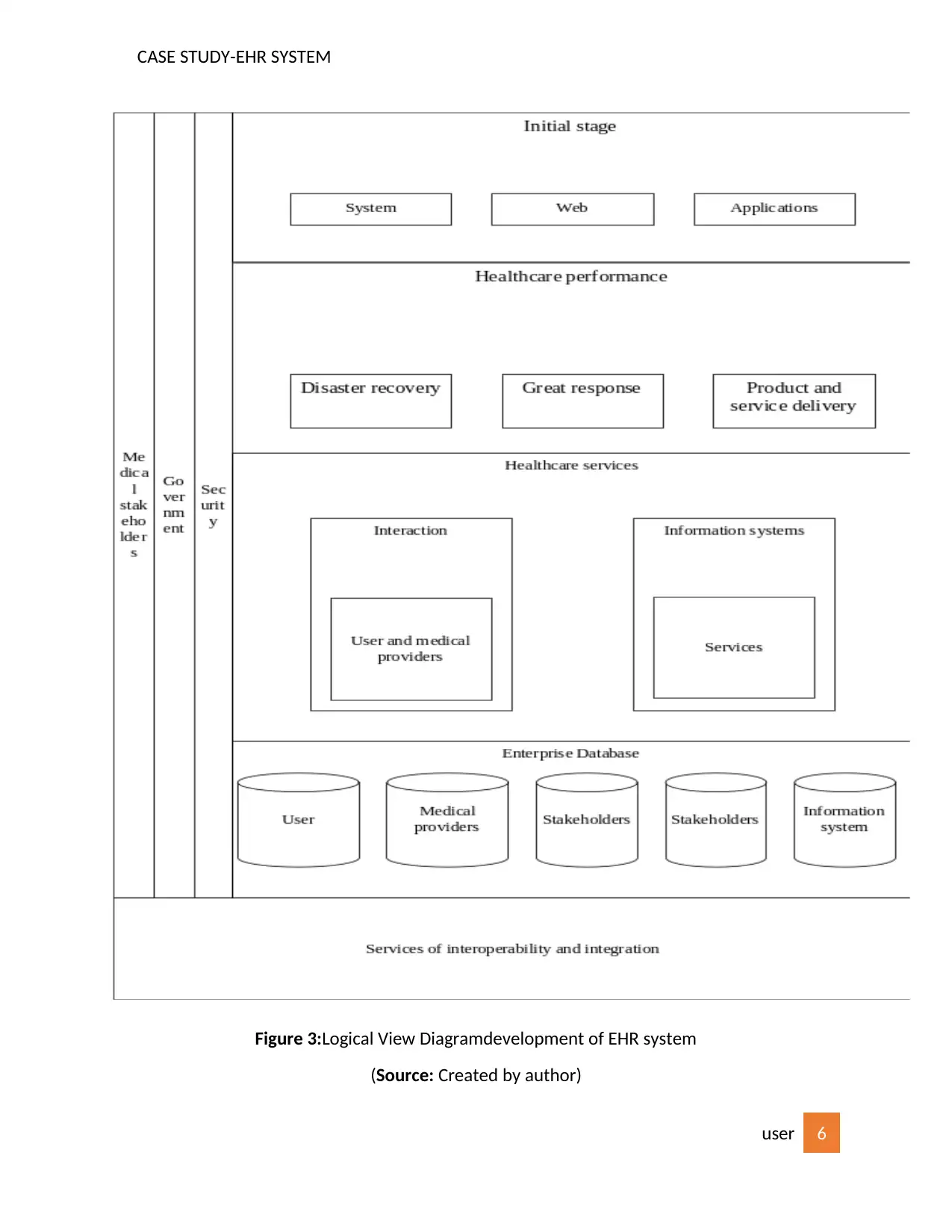
CASE STUDY-EHR SYSTEM
Figure 3:Logical View Diagramdevelopment of EHR system
(Source: Created by author)
user 6
Figure 3:Logical View Diagramdevelopment of EHR system
(Source: Created by author)
user 6
⊘ This is a preview!⊘
Do you want full access?
Subscribe today to unlock all pages.

Trusted by 1+ million students worldwide
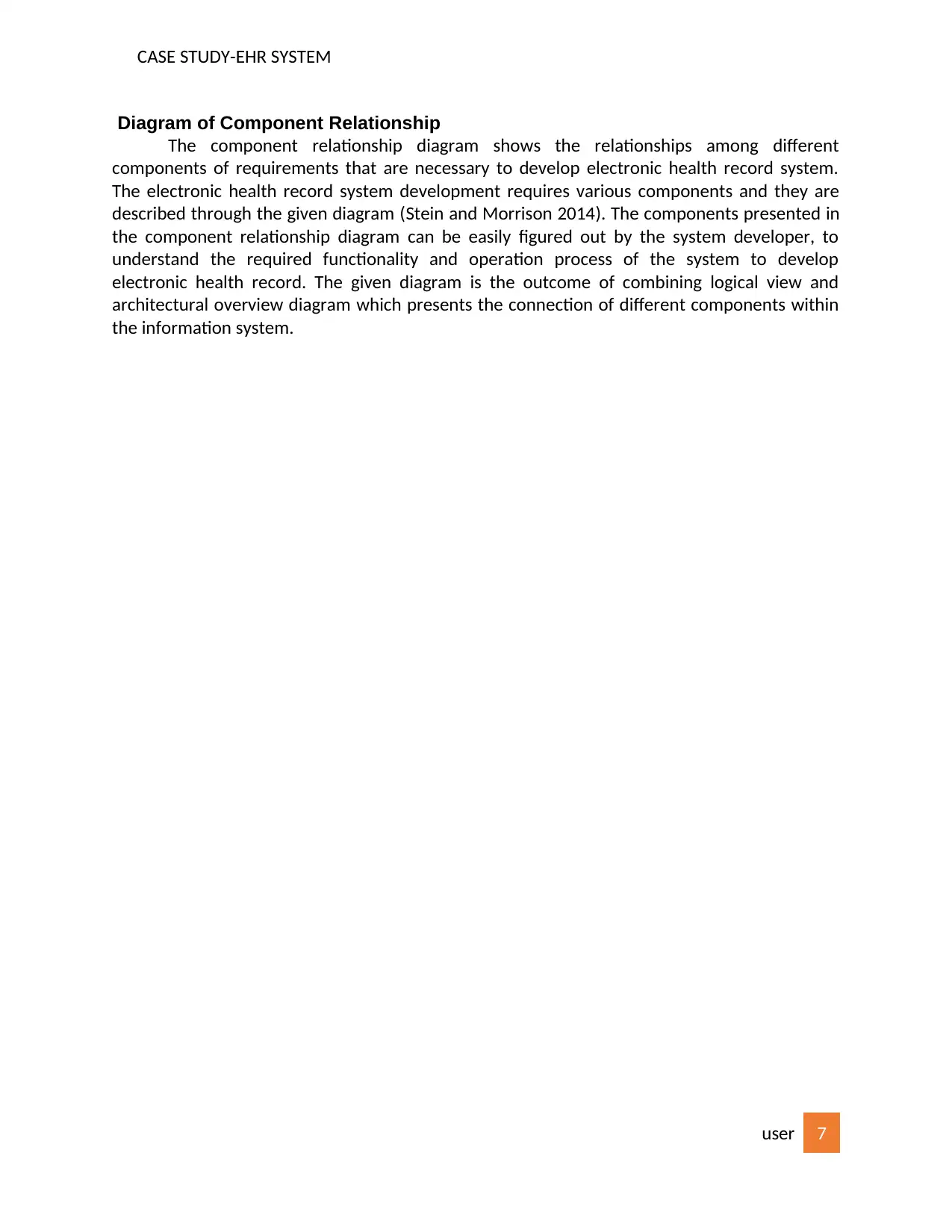
CASE STUDY-EHR SYSTEM
Diagram of Component Relationship
The component relationship diagram shows the relationships among different
components of requirements that are necessary to develop electronic health record system.
The electronic health record system development requires various components and they are
described through the given diagram (Stein and Morrison 2014). The components presented in
the component relationship diagram can be easily figured out by the system developer, to
understand the required functionality and operation process of the system to develop
electronic health record. The given diagram is the outcome of combining logical view and
architectural overview diagram which presents the connection of different components within
the information system.
user 7
Diagram of Component Relationship
The component relationship diagram shows the relationships among different
components of requirements that are necessary to develop electronic health record system.
The electronic health record system development requires various components and they are
described through the given diagram (Stein and Morrison 2014). The components presented in
the component relationship diagram can be easily figured out by the system developer, to
understand the required functionality and operation process of the system to develop
electronic health record. The given diagram is the outcome of combining logical view and
architectural overview diagram which presents the connection of different components within
the information system.
user 7
Paraphrase This Document
Need a fresh take? Get an instant paraphrase of this document with our AI Paraphraser
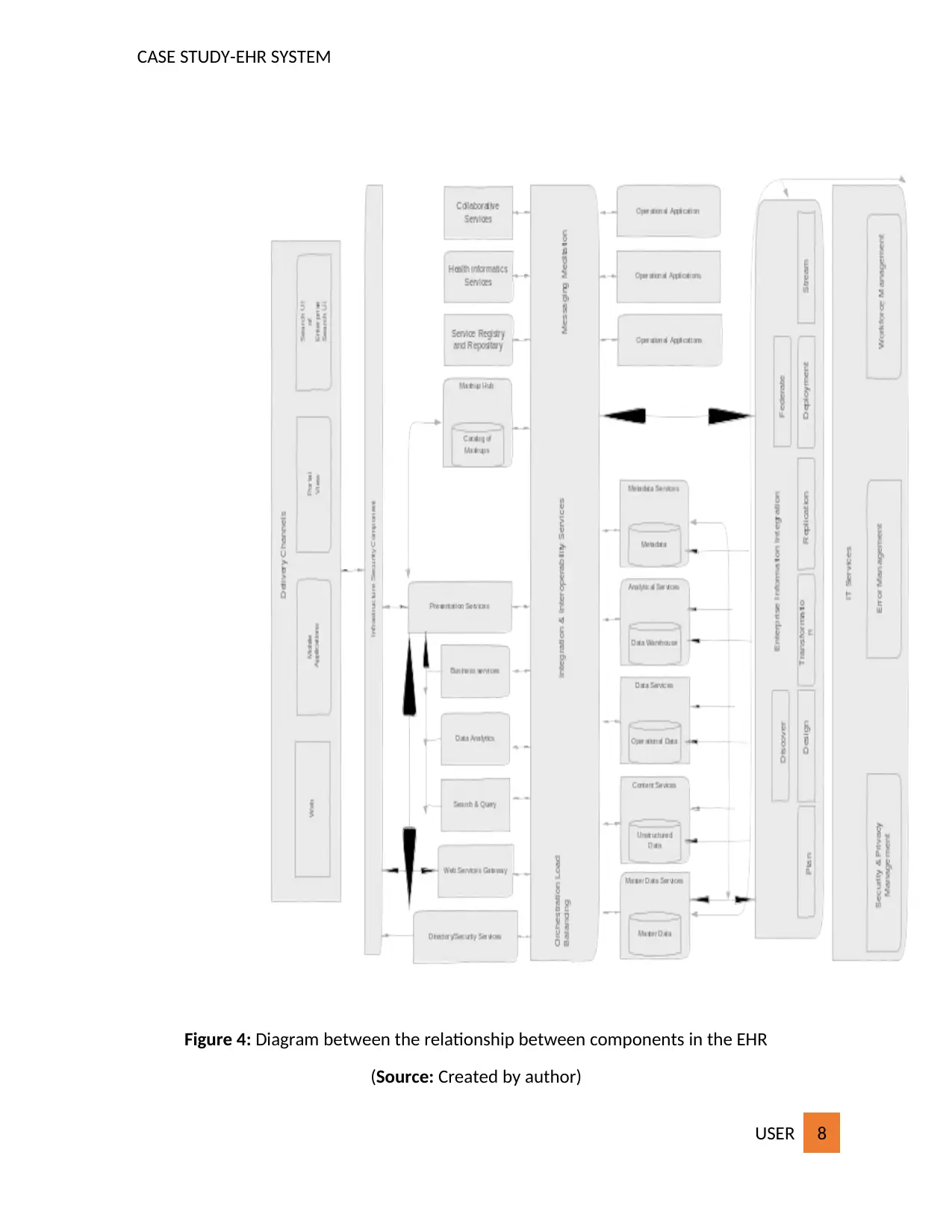
CASE STUDY-EHR SYSTEM
Figure 4: Diagram between the relationship between components in the EHR
(Source: Created by author)
USER 8
Figure 4: Diagram between the relationship between components in the EHR
(Source: Created by author)
USER 8
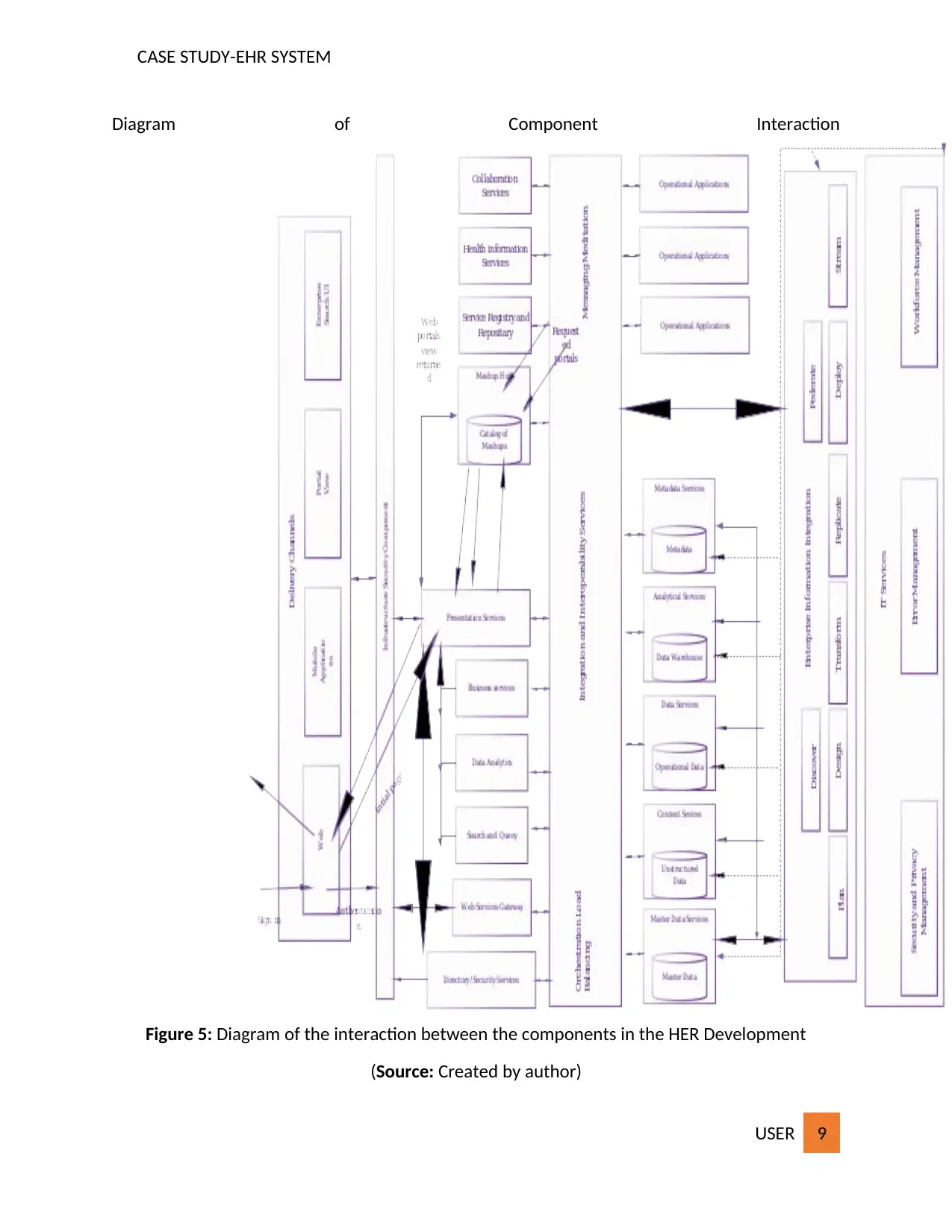
CASE STUDY-EHR SYSTEM
Diagram of Component Interaction
Figure 5: Diagram of the interaction between the components in the HER Development
(Source: Created by author)
USER 9
Diagram of Component Interaction
Figure 5: Diagram of the interaction between the components in the HER Development
(Source: Created by author)
USER 9
⊘ This is a preview!⊘
Do you want full access?
Subscribe today to unlock all pages.

Trusted by 1+ million students worldwide
1 out of 17
Related Documents
Your All-in-One AI-Powered Toolkit for Academic Success.
+13062052269
info@desklib.com
Available 24*7 on WhatsApp / Email
![[object Object]](/_next/static/media/star-bottom.7253800d.svg)
Unlock your academic potential
Copyright © 2020–2025 A2Z Services. All Rights Reserved. Developed and managed by ZUCOL.




